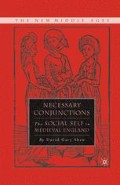Abstract
It has been a common feature of medieval urban histories to conclude, typically in an appendix, with brief notes on individuals, listing the bare bones of the documentary evidence. It was not always clear what the purpose of these was, possibly help to the local antiquarians keen on family history or for future biographers or prosopographers, with large computers and high hopes. Regardless of intention, it captured the essence of the social history of previous decades, in which the individual was something of an afterthought. At any rate, this chapter, a culmination of this book in many ways, is their descendant, bred, however, to take the individuals and the notions they lived by, more seriously. Yet, here is the problem from which we started: the difficulty of scraping up the medieval individual. The meaning of individual has now changed and become a kind of dialogue of self and world as the social self, but the problem remains and we should remind ourselves with the limiting case of Cecily Pontefract.
Access this chapter
Tax calculation will be finalised at checkout
Purchases are for personal use only
Preview
Unable to display preview. Download preview PDF.
Notes
Rose Mazo Karras, Common Women (New York: Oxford University Press, 1996)
Ann J. Kettle, “Ruined Maids: Prostitution and Servant Girls in Later Medieval England,” in Matrons and Marginal Women in Medieval Society, ed. Robert E. Edwards and Vickie Ziegler (Woodbridge: Boydell Press, 1995), pp. 19–31;
Stephen O’Connor, “Adam Fraunceys and John Pyel: Perceptions of Status among Merchants in Fourteenth-Century London,” in Trade, Devotion, and Governance, ed. Dorothy J. Clayton, Richard G. Davies, and Peter McNiven (Stroud: A. Sutton, 1994), pp. 17–35
Charles Phythian-Adams, Desolation of a City: Coventry and the Urban Crisis of the Late Middle Ages (Cambridge, UK: Cambridge University Press, 1979), pp. 124–28.
Stephen Rigby, English Society in the Later Middle Ages. Class, Status and Gender (New York: St. Martin’s Press, 1995).
Rosemary Horrox, “The Urban Gentry in the Fifteenth Century,” in Towns and Townspeople in the Fifteenth Century, ed. J.A.F. Thomson (Gloucester: Alan Sutton, 1983), pp. 22–44;
Sylvia L. Thrupp, The Merchant Class of Medieval London (Ann Arbor: University of Michigan Press, 1948), pp. 256–87
Christine Carpenter, “Town and ‘Country’: The Stratford Guild and Political Networks of Fifteenth-Century Warwickshire,” in The History of an English Borough. Stratford-upon-Avon, ed. R. Bearman (Stroud: Sutton, 1997), pp. 62–79
Miri Rubin, Charity and Community in Medieval Cambridge (Cambridge: Cambridge University Press, 1987), pp. 148–72;
This is the argument of Katherine French, People of the Parish: Community Life in a Late Medieval English Diocese (Philadelphia: University of Pennsylvania Press, 2001) pp. 68–98,
J.A. Raftis, Peasant Economic Development within the English Manorial System (Montreal: McGill-Queen’s University Press, 1997), esp. pp. 75–8.
See Kathleen Edwards, The English Secular Cathedrals in the Middle Ages (Manchester: Manchester University Press, 1967), pp. 195–208.
Judith Bennett, Women in the Medieval English Countryside (New York: Oxford University Press, 1987), 142–76.
Cf. Jennifer Ward, “Townswomen and their Households,” in Daily Life in the Late Middle Ages, ed. Richard Britnell (Stroud: Sutton Publishing, 1998), pp. 30–31.
Ralph A. Houlbrooke, The English Family 1450–1700 (London: Longman, 1984), pp. 96–105;
Barbara Hanawalt, The Ties that Bound (New York: Oxford University Press, 1986).
See B.F. Harvey, “Draft Letters Patent of Manumission and Pardon for the Men of Somerset in 1381,” English Historical Review 80 (1965): 89–91;
Copyright information
© 2005 David Gary Shaw
About this chapter
Cite this chapter
Shaw, D.G. (2005). A World of Individuals. In: Necessary Conjunctions: The Social Self in Medieval England. The New Middle Ages. Palgrave Macmillan, New York. https://doi.org/10.1007/978-1-137-06791-3_8
Download citation
DOI: https://doi.org/10.1007/978-1-137-06791-3_8
Publisher Name: Palgrave Macmillan, New York
Print ISBN: 978-1-349-73357-6
Online ISBN: 978-1-137-06791-3
eBook Packages: Palgrave History CollectionHistory (R0)

